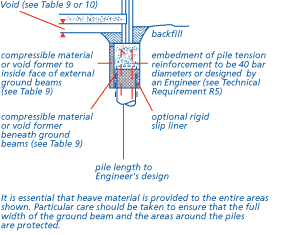4.2 Building near trees
SITEWORK STANDARDS
(a) meet the Technical Requirements
(b) take account of the design
(c) follow established good practice and workmanship
Sitework that complies with the design and guidance below will be acceptable for building near trees.
FOUNDATION DEPTHS
A site plan should show the trees and hedgerows that affect the site together with the type, depth and dimensions of the foundations that are within the influence of those trees and hedgerows. Where trees or hedgerows are either not shown or are in different positions and there is shrinkable soil, it may be necessary to adjust the foundation depths on site. Foundation depths should be determined in accordance with Design clause D6 or the foundation depth calculator. If in doubt about any of the information either assume the worst conditions or consult a suitably qualified Engineer.
An Engineer should be consulted where foundation depths exceed 2.5m (see Technical Requirements R5).
Figure 4 NHBC foundation depth calculator
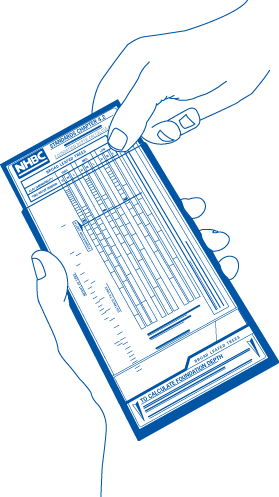
EXCAVATION FOR FOUNDATIONS
Items to be taken into account include:
Foundation depths should be measured on the centre line of the excavation.
Where ground levels are to remain unaltered foundation depths should be measured from original ground level.
Where
ground levels are reduced or increased (either in the recent past or
during construction) foundation depths should be measured as shown in
Figures 5 to 7.
Figure 5 Levels from which foundation depths are measured where trees or hedgerows are to remain
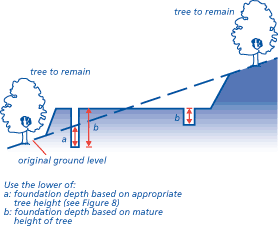
Figure 6 Levels from which foundation depths are measured where trees or hedgerows are removed
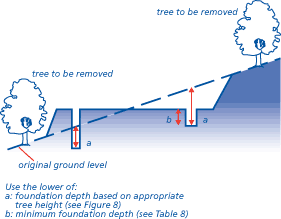
Figure 7 Levels from which foundation depths are measured where trees or hedgerows are proposed
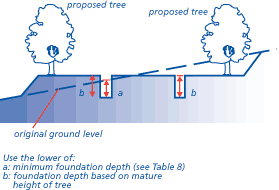
Figure 8 Tree height H to be used for particular design cases
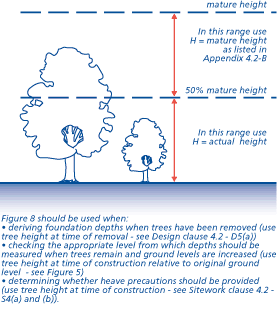
Table 8 Minimum foundation depths
| Volume change potential | Minimum depth [m] |
| High | 1.0 |
| Medium | 0.9 |
| Low | 0.75 |
For stepped foundations, the relevant recommendations of Chapter 4.4 'Strip and trench fill foundations' should be followed with the additional precaution that the maximum step height should not exceed 0.5m as shown in Figure 9.
On sloping ground, foundation trenches can be gradually stepped so that the required foundation depth is reasonably uniform below ground level.
Figure 9 Stepped foundations
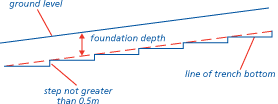
Where trench bottoms become excessively
dried or softened due to rain or ground water, the excavation should be re-bottomed prior to concreting.
Some root activity may be expected below the depths determined in accordance with Design clause D6. However, if significant quantities of roots are unexpectedly encountered in the base of the trench, the excavation should be deepened or consult an Engineer.
HEAVE PRECAUTIONS
The following details show the minimum requirements for common foundation types. They apply to all foundations within the zone of influence of trees which are to remain or be removed.
Correct placement of heave materials is essential to ensure the foundations and substructure are adequately protected from heave forces.
Heave precautions should be provided as shown in Figure 10.
Compressible material should be provided against the inside faces of all external wall foundations greater than 1.5m deep based on the appropriate tree height (see Figure 8).
No compressible material is required against the faces of internal foundations.
Heave precautions are not required for proposed trees as the soil has not been desiccated and therefore heave cannot take place.
Figure 10 Heave precautions for trench fill foundations up to 2.5m deep
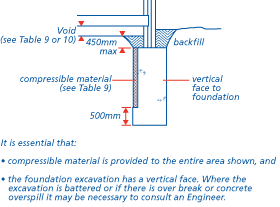
Trench fill foundations deeper than 2.5m will only be acceptable where they are designed by an Engineer (see Technical Requirement R5).
Heave precautions should be provided as shown in Figure 11.
Compressible material should be provided against all faces of the pier foundation which are greater than 1.5m deep based on the appropriate tree height (see Figure 8).
A void, void former or compressible material should be provided below all ground beams.
Compressible material or a void former should also be provided against the inside faces of external ground beams unless NHBC is satisfied that the soil, at this level, is not desiccated.
Heave precautions are not required for proposed trees as the soil has not been desiccated and heave cannot take place.
Figure 11 Heave precautions for pier and beam foundations
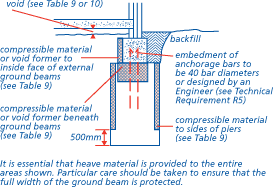
Heave precautions should be provided as shown in Figure 12.
A void, void former or compressible material should be provided below all ground beams.
Compressible material or a void former should also be provided against the inside faces of external ground beams unless NHBC is satisfied that the soil, at this level, is not desiccated.
Heave precautions are not required for proposed trees as the soil has not been desiccated and heave cannot take place.
Figure 12 Heave precautions for pile and beam foundations
Voids should be provided to accommodate movement in accordance with Tables 9 and 10.
Table 9 Minimum void dimension for foundations, ground beams and suspended in-situ concrete ground floors
| Against side of foundation and ground beam | Under ground beam and suspended in-situ concrete ground floor | |
| Volume change potential | Void dimension [mm]1 | Void dimension [mm]1 |
| High | 35 | 150 |
| Medium | 25 | 100 |
| Low | 0 | 50 |
Note:
- For compressible material the void dimension is the amount the material should be able to compress to accommodate heave. The actual thickness of compressible material required should be established from the manufacturer's recommendations and is generally in the order of twice the void dimension shown. For void formers the void dimension is the remaining void after collapse. The actual thickness of void former required should be established from the manufacturer's recommendations.
Table 10 Minimum void dimensions under precast concrete and timber ground floors
| Precast concrete | Suspended timber | |
| Soil heave potential | Void dimension [mm]1 | Void dimension [mm]2 |
| High | 225 | 300 |
| Medium | 175 | 250 |
| Low | 125 | 200 |
Note:
- Measurement from underside of beam to ground level (includes 75mm ventilation allowance).
- Measurement from underside of joist to ground level (includes 150mm ventilation allowance).
DRAINAGE
Drainage construction should be in accordance with the design and the relevant recommendations of Chapter 5.3 'Drainage below ground' should be followed.
Additional items to take into account include:
- falls should be sufficient to cater for possible ground movement or alternative means should be used to reduce the extent of potential movement, for example by taking the excavation deeper and laying the pipework on granular bedding of suitable thickness
- a drainage system capable of accommodating the likely movement should be used
- pipes passing through substructure walls or trench fill foundations should have sufficient clearance to take account of the potential ground movement indicated in Table 11.
Table 11 Minimum allowance for potential ground movement
| Volume change potential | Potential ground movement [m] |
| High | 150 |
| Medium | 100 |
| Low | 50 |
Existing land drains should be maintained or diverted. Where the
void beneath suspended floors is liable to flooding, drainage should be
provided.



















